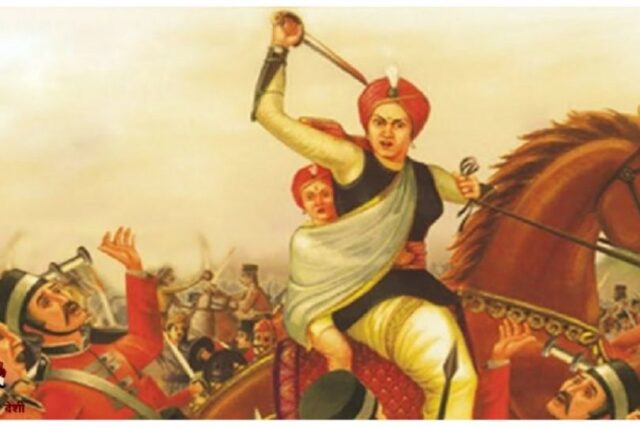
(June 18 – Rani Lakshmi Bai BaliDan Diwas)
Lakshmi Bai, also spelled as Laxmi Bai, born on November 19, 1835, Kashi, India and died on June 18, 1858, Kotah-ki-Serai, near Gwalior was an Indian queen of the Maratha princely state of Jhansi in North India currently present in Jhansi district in Uttar Pradesh, India. She was one of the leading figures of the Indian war of Independence 1857 and emerged as a symbol of resistance to the British Raj for Indian nationalists.
Rani Lakshmibai was born on 19 November 1828 in the town of Varanasi to a Marathi Karhade Brahmin couple Moropant Tambe and Bhagirathi Sapre. She was named Manikarnika Tambe and was nicknamed later as Manu. Her mother died when she was four years old. Her father worked for Peshwa Baji Rao II of Bithoor district.The Peshwa called her “Chhabili”, which means “playful”. She was educated at home, with freedom to read and write, and was more independent in her childhood than others of her age; her studies included shooting, horsemanship, fencing and mallakhamba with her childhood friends Nana Sahib and Tatya Tope.
Rani Lakshmibai was accustomed to riding on horseback accompanied by a small escort between the palace and the temple although sometimes she was carried by palanquin.Her horses included Sarangi, Pavan and Baadal.As per archival evidences she rode Baadal when escaping from the fort in 1858. The Rani Mahal, the palace of Rani Lakshmibai, has now been converted into a museum.
Battle at Jhansi and the final scarifice
The British force arrived in Jhansi on the morning of March 21, 1858, and the attack began. The Rani asked Tatya Tope for help, but he failed although he came with 22, 000 men.However, the defeat encouraged the Rani, and she supervised the defence. General Rose stormed the fort on the morning of April 3, 1858. The next day Jhansi went under British control, and the fort was occupied on April 5, 1858.Historian S.N. Sinha has written is that the Rani dressed as a man and along with her followers left the fort in the night of April 4, or the morning of April 5, 1858. In any case, the Rani rode along the road leading to the city of Kalpi. In Kalpi, they planned to resist British force, but they failed. Then, the revolutionaries moved in the direction of Gwalior, where they first succeeded. On the June 18, 1858 the British attacked the revolutionaries and forced them to retreat. In this action, the Rani died. The final battle was fought on June 19, 1858. The Rani had been riding a horse, got stuck by bullets and fell. Some say that the Rani survived about twenty minutes. The arrangement was done instantly after her death for cremating her body. General Rose stated that the Rani was not killed on the field, but was carried off the ground and ordered a funeral pile which she fired by herself. Another version of the legend is that the Rani deliberately chose death over life under British rule.
Twenty years after her death Colonel Malleson wrote in the History of the Indian Mutiny; vol. 3; London, 1878 ‘Whatever her faults in British eyes may have been, her countrymen will ever remember that she was driven by ill-treatment into rebellion, and that she lived and died for her country, We cannot forget her contribution for India.”
Fear of colonial reprisal had prevented anybody from attempting a truthful history of Lakshmibai but the texts by Godse, Vrindavan Lal Verma and Paranis and living oral traditions has kept the bravery of queen alive.
Her unbeatable bravery, courage and fighting spirit is duly recognized in the form of Statues of Lakshmibai across India. Lakshmibai National University of Physical Education in Gwalior, Laksmibai National College of Physical Education in Thiruvananthapuram, Maharani Laxmi Bai Medical College in Jhansi are named after her. Rani Lakshmi Bai Central Agricultural University in Jhansi was founded in 2013. The Rani Jhansi Marine National Park is located in the Andaman and Nicobar Islands in the Bay of Bengal. A women’s unit of the Indian National Army was named the Rani of Jhansi Regiment. In 1957 two postage stamps were issued to commemorate the centenary of the rebellion. Indian representations in novels, poetry, and film tend towards an uncomplicated valorization of Rani Lakshmibai as an individual solely devoted to the cause of Indian independence.














